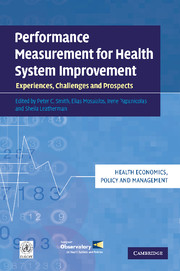Book contents
- Frontmatter
- Contents
- Foreword
- Acknowledgements
- List of contributors
- List of boxes, figures and tables
- Part I Principles of performance measurement
- Part II Dimensions of performance
- Part III Analytical methodology for performance measurement
- Part IV Performance measurement in specific domains
- Part V Health policy and performance measurement
- 5.1 Targets and performance measurement
- 5.2 Public performance reporting on quality information
- 5.3 Developing information technology capacity for performance measurement
- 5.4 Incentives for health-care performance improvement
- 5.5 Performance measurement and professional improvement
- 5.6 International health system comparisons: from measurement challenge to management tool
- Part VI Conclusions
- Index
5.5 - Performance measurement and professional improvement
Published online by Cambridge University Press: 06 July 2010
- Frontmatter
- Contents
- Foreword
- Acknowledgements
- List of contributors
- List of boxes, figures and tables
- Part I Principles of performance measurement
- Part II Dimensions of performance
- Part III Analytical methodology for performance measurement
- Part IV Performance measurement in specific domains
- Part V Health policy and performance measurement
- 5.1 Targets and performance measurement
- 5.2 Public performance reporting on quality information
- 5.3 Developing information technology capacity for performance measurement
- 5.4 Incentives for health-care performance improvement
- 5.5 Performance measurement and professional improvement
- 5.6 International health system comparisons: from measurement challenge to management tool
- Part VI Conclusions
- Index
Summary
Introduction
As many of the preceding chapters have established, measurement is clearly the first step in improving quality of care. If performance cannot be measured, you cannot genuinely determine how well you are doing or whether different approaches to health-care delivery are associated with higher or lower quality. However, measurement is only part of the answer. Most health care is provided by individual clinicians practising in a variety of sites and there will be no predictable and systematic progress in improving quality unless these professionals become engaged in collecting and using performance data to effect change. This chapter focuses specifically on these issues, particularly the relationship between various aspects of performance measurement and professional improvement.
Quality assurance, quality improvement and performance measurement
Historically, quality management was the province of individual doctors, their professional organizations and the state; the latter exercising control largely through licensure (Epstein 1996). Institutional quality assurance developed in the latter half of the twentieth century as a result of the increasing scientific basis of clinical care; complexity of technology; congregation of different sorts of providers (e.g. physicians, nurses, nutritionists, pharmacists) in hospitals and group practice settings; and the advent of accreditation.
Initial quality assurance efforts in hospitals focused largely on structure and process indicators. Analyses of insurance claims data employed to identify providers who overused services for different clinical conditions or in particular clinical circumstances were also deemed quality assurance efforts in some instances.
- Type
- Chapter
- Information
- Performance Measurement for Health System ImprovementExperiences, Challenges and Prospects, pp. 613 - 640Publisher: Cambridge University PressPrint publication year: 2010
- 1
- Cited by

